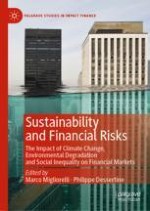2020 | OriginalPaper | Chapter
5. Sustainability-Related Risks and Financial Stability: A Systemic View and Preliminary Conclusions
Authors : Marco Migliorelli, Nicola Ciampoli, Philippe Dessertine
Published in: Sustainability and Financial Risks
Publisher: Springer International Publishing
Activate our intelligent search to find suitable subject content or patents.
Select sections of text to find matching patents with Artificial Intelligence. powered by
Select sections of text to find additional relevant content using AI-assisted search. powered by
